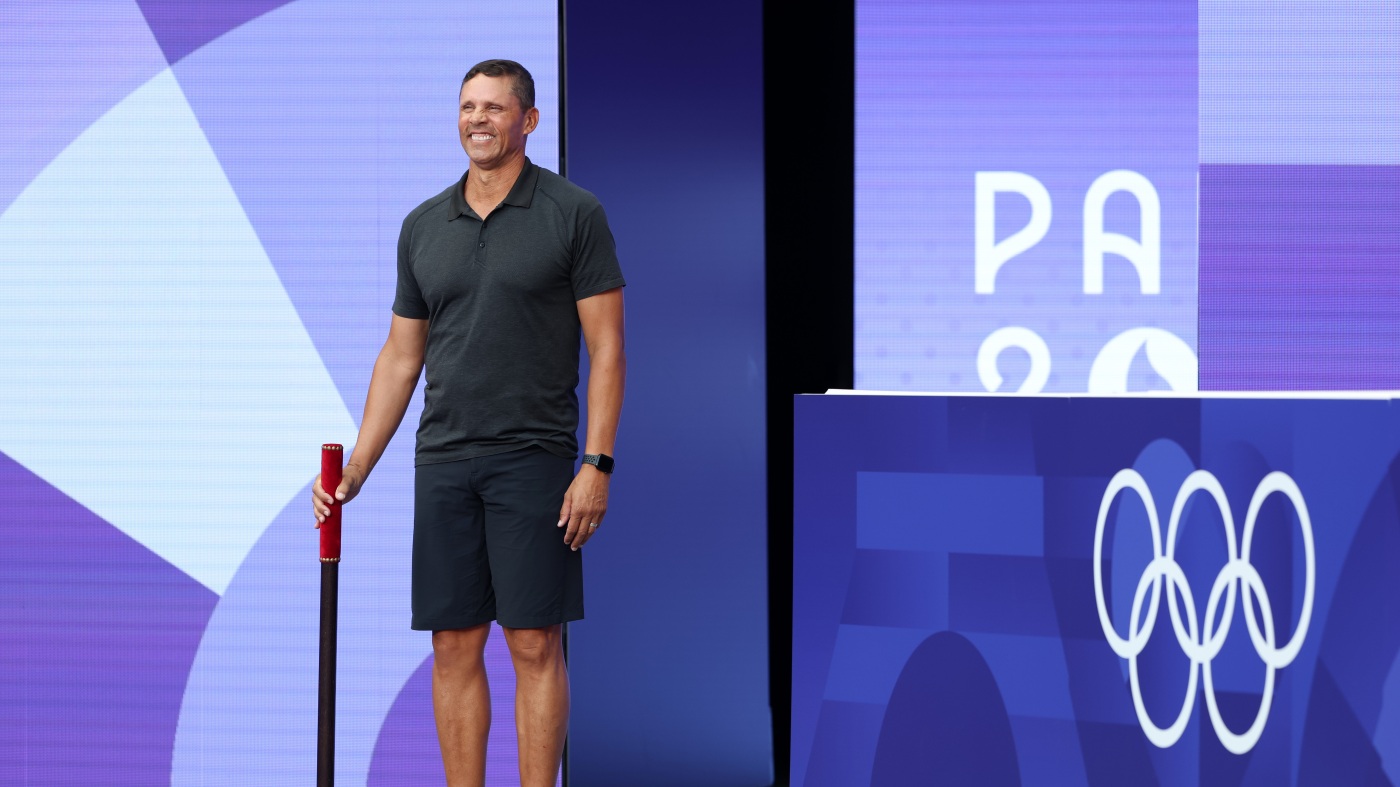Dan O’Brien, a former American decathlete, bears the brigadier ahead of the High Jump portion of the Decathlon at Stade de France on Friday. He’s about to command the attention of the stadium’s raucous crowd as part of a new, very French Olympic custom.
Hannah Peters/Getty Images
hide caption
toggle caption
Hannah Peters/Getty Images
PARIS — Minutes before tipoff at a men’s 3-on-3 basketball game, a curious act unfolded.
Two men walked onto the court, with them a tall, wooden staff. You could tell by their garb they were not Olympic athletes.
Then, slowly, thump-thump-thump.
The pair passed the thick stick back and forth, taking it to pound the floor each time.
The three blows thundered through the outdoor stadium, hushing the buzzy crowd. Upon its conclusion, the spectators broke into applause.
The men who had effectively commanded the crowd with three easy strikes of a baton were Bruno Gouery and William Abadie — French actors recognizable from the Netflix show Emily in Paris.
It was at once all very light-hearted and serious. Come to find out, the practice is borrowed from the dramatic arts.
It’s called the “three ground strikes” — or, les trois coups, s’il vous plait. It’s a new, fittingly French, Olympics ritual that was introduced for the first time this year at the Paris Games.
The custom is borrowed from an ages-old practice found on French performance stages. But at the Paris Games, it’s meant to connect spectators with athletes, and to celebrate the host country’s theatrical heritage, organizers say.
The trois coups happens at the top of each sporting session at Olympic venues to mark the start of play.
The honors aren’t strictly bestowed to Emily in Paris cast members.
A “former or current” sportsman or sportswoman, a volunteer, public figure or often a completely anonymous person may commence les trois coups, according to organizers.

Daniel Carter, retired New Zealand rugby player, bears the brigadier upon entering the stadium during the Men’s Rugby Sevens group match between Australia and Samoa at Stade de France on July 24, 2024.
Hannah Peters/Getty Images
hide caption
toggle caption
Hannah Peters/Getty Images
Tennis great Billie Jean King performed the three-strikes ritual ahead of the Rafael Nadal-Carlos Alcaraz doubles match at Roland Garros. Indian Olympic gold medalist Abhinav Bindra tapped the stick signal the start of Ramita Jindal’s 10-meter air rifle event.
From the French theater to the Olympic venue
The custom was, and in many cases continues to be, present in French classical theater.
But there’s a lot of disagreement about the origins’ specifics, including the number of strikes that should be deployed.
Some scholars say trois coups harkens back to France’s first professional theater, during the Middle Ages, when it was said to evoke religious symbolism — the three blows representing the Holy Trinity.
Others put forth a secular take. Paul Gousset, a former technical director of the Royal Opera of Versailles, has explained the use of the three blows before a stage play “as signaling a final check that all was in readiness to begin the production,” according to researcher Marvin Carlson.
By Gousset’s telling, the series of blows was used communicate not to the audience but to the backstage crew: “the head technicians above the stage, below it, and on the side opposite the brigadier, would each give a single blow to show that their area was ready to proceed,” wrote Carlson.
The stick used to command the crowd is called a “brigadier.” A brigadier is usually used to describe one who commands a military brigade, yes, but does not a stage manager lead his theater brigade?
That’s the idea, according to organizers. It was a term used so often to refer to a stick-wielding stage manager that, through the magic of metonymy, the stick itself is now referred to as a brigadier.
But what of its use in athleticism today? The ritual is meant to leave fans with a little souvenir of French culture, bring together theater and sport, and to effectively tell the crowd: Silence — you’re about to see a thrilling show.
“These three strokes are designed to remind us that each event is a unique performance that deserves the public’s attention and respect,” the Olympics website says. “Spectators are invited to observe a moment of silence at the moment of the three blows, just like in the theatre.”




